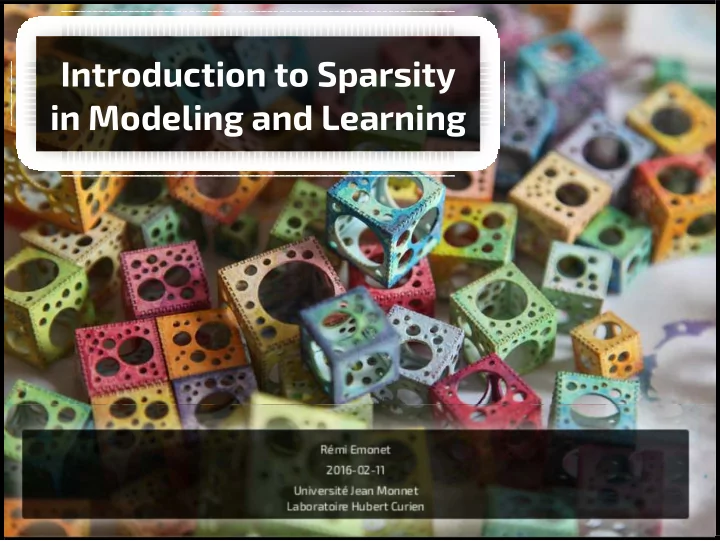

Introduction to Sparsity in Modeling and Learning
Introduction to Sparsity in Modeling and Learning The Curse of Dimensionality Ockham's Razor Notions of Simplicity Conclusion U M R •C N RS •551 6 •SAIN T -ETIEN N E 2 / 21 − Rémi Emonet − Introduction to Sparsity in Modeling and Learning
The Curse of Dimensionality 3 / 21 − Rémi Emonet − Introduction to Sparsity in Modeling and Learning
The Curse of Dimensionality is can be High-dimensionality a mess.
What is this Curse Anyway? Some definition: Various phenomena that arise when analyzing and organizing data in high-dimensional spaces. Term coined by Richard E. Bellman 1920 − 1984 dynamic programming differential equations shortest path What is (not) the cause? not an intrinsic property of the data depends on the representation depends on how data is analyzed 5 / 21 − Rémi Emonet − Introduction to Sparsity in Modeling and Learning
Combinatorial Explosion Suppose you have d entities each can be in 2 states Then there are 2 combinations to consider/test/evaluate d Happens when considering d all possible subsets of a set ( 2 ) all permutations of a list ( d ! ) d all affectations of entities to labels ( k , with k labels) { } { } { } { } {a} { b} { c} { d} {a } { b } { c } {a,b} { b,c} { c,d} {a } { b } {a, c} { b, d} {a,b } { b,c } {a,b,c} { b,c,d} {a } {a, d} {a, c } 6 / 21 − Rémi Emonet − Introduction to Sparsity in Modeling and Learning
Regular Space Coverage Analogous to combinatorial explosion, in continuous spaces Happens when considering histograms density estimation anomaly detection ... 7 / 21 − Rémi Emonet − Introduction to Sparsity in Modeling and Learning
In Modeling and Learning The world is complicated state with a huge number of variables (dimensions) possibly noisy observations e.g. a 1M-pixel image has 3 million dimensions Learning would need observations for each state it would require too many examples need for an “interpolation” procedure, to avoid overfitting Hughes phenomenon, 1968 paper (which is wrong, it seems) given a (small) number of training samples, additional feature measurements may reduce the performance of a statistical classifier 8 / 21 − Rémi Emonet − Introduction to Sparsity in Modeling and Learning
A Focus on Distances/Volumes Considering a d dimensional space About volumes volume of the cube: C ( r ) = (2 r ) d d π d /2 d volume of a sphere with radius r : S ( r ) = r d Γ( d + 1) 2 ( Γ is the continuous generalization of the factorial) S ( r ) d → 0 (linked to space coverage) ratio: C ( r ) d 9 / 21 − Rémi Emonet − Introduction to Sparsity in Modeling and Learning
A Focus on Distances/Volumes (cont'd) About distances average (euclidean) distance between two random points? everything becomes almost as “far” Happens when considering radial distributions (multivariate normal, etc) k-nearest neighbors (hubiness problem) other distance-based algorithms 10 / 21 − Rémi Emonet − Introduction to Sparsity in Modeling and Learning
The Curse of Dimensionality Many things get degenerated with high dimensions Problem of: approach + data representation We have to hope that there is no curse
Introduction to Sparsity in Modeling and Learning The Curse of Dimensionality Ockham's Razor Notions of Simplicity Conclusion U M R •C N RS •551 6 •SAIN T -ETIEN N E 12 / 21 − Rémi Emonet − Introduction to Sparsity in Modeling and Learning
Shave unnecessary assumptions. Ockham's Razor
Ockham's Razor th Term from 1852, in reference to Ockham (XIV ) lex parsimoniae , law of parsimony Prefer the simplest hypothesis that fits the data. Formulations by Ockham, but also earlier and later More a concept than a rule simplicity parsimony elegance shortness of explanation shortness of program (Kolmogorov complexity) falsifiability (sciencific method) According to Jürgen Schmidhuber, the appropriate mathematical theory of Occam's razor already exists, namely, Solomonoff's theory of optimal inductive inference. 14 / 21 − Rémi Emonet − Introduction to Sparsity in Modeling and Learning
Notions of Simplicity 15 / 21 − Rémi Emonet − Introduction to Sparsity in Modeling and Learning
Simplicity of Data: subspaces Data might be high-dimensional, but we have hope that there is a organization or regularity in the high-dimensionality that we can guess it or, that we can learn/find it Approaches: dimensionality reduction, manifold learning PCA, kPCA, *PCA, SOM, Isomap, GPLVM, LLE, NMF, … 16 / 21 − Rémi Emonet − Introduction to Sparsity in Modeling and Learning
Simplicity of Data: compressibility Idea data can be high dimensional but compressible i.e., there exist a compact representation Program that generates the data (Kolmogorov complexity) Sparse representations wavelets (jpeg), fourier transform sparse coding, representation learning Minimum description length size of the “code” + size of the encoded data 17 / 21 − Rémi Emonet − Introduction to Sparsity in Modeling and Learning
Simplicity of Models: information criteria Used to select a model Penalizes by the number k of free parameters AIC (Aikake Information Criterion) penalizes the Negative-Log-Likelihood by k BIC (Bayesian IC) penalizes the NLL by k log( n ) (for n observations) BPIC (Bayesian Predictive IC) DIC (Deviance IC) FIC (Focused IC) Hannan-Quinn IC TIC (Takeuchi IC) Sparsity of the parameter vector ( l 0 norm) penalizes the number of non-zero parameters 18 / 21 − Rémi Emonet − Introduction to Sparsity in Modeling and Learning
Take-home Message
Thank You! Questions?
Recommend
More recommend